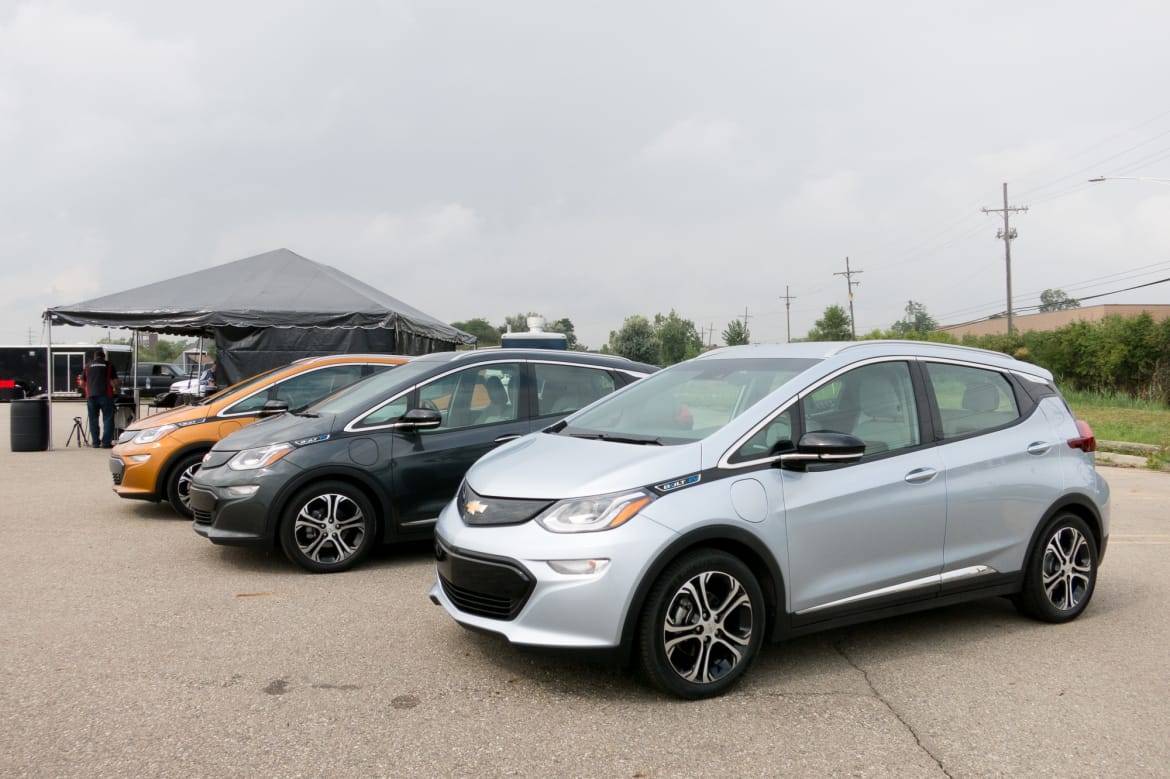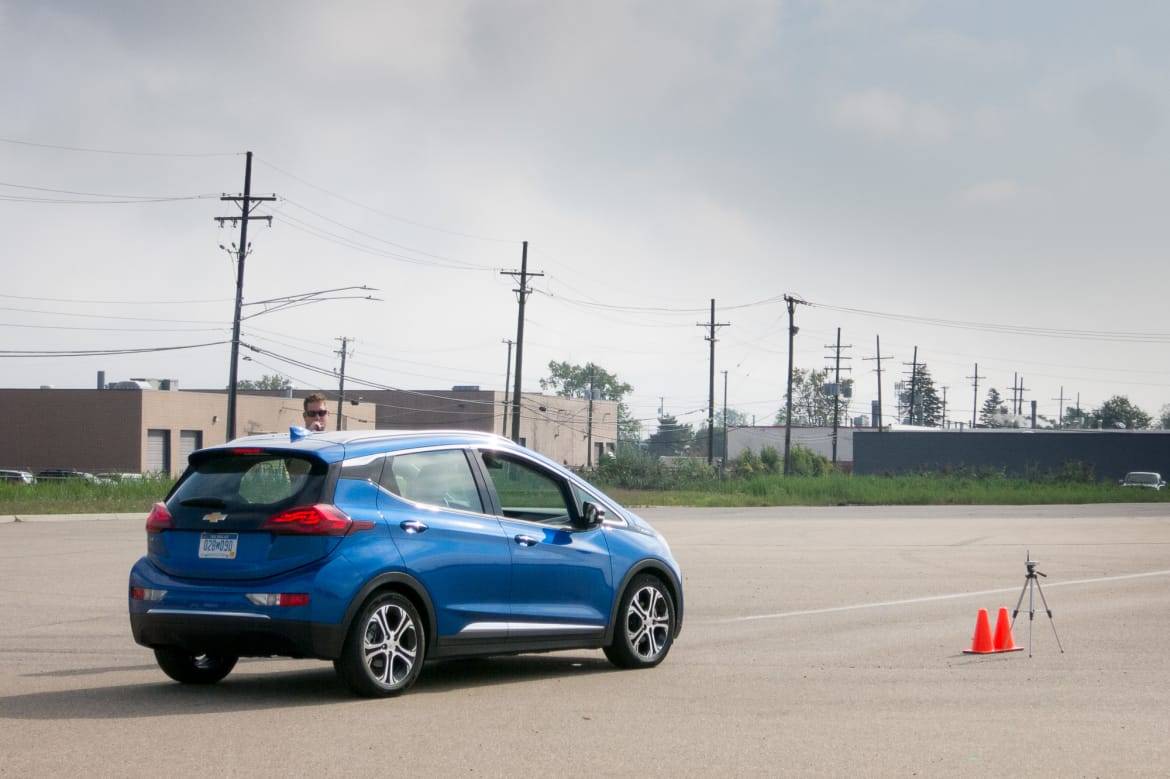2017 Chevrolet Bolt EV: Autocross Examination


CARS.COM — By now, it’s no longer a secret that electric cars can be a lot of fun to drive. Witness the Tesla Model S P100D, which has become one of the quickest-accelerating vehicles you can buy, embarrassing dedicated supercars costing hundreds of thousands of dollars more. But not everyone has the kind of coin to throw around to snag an expensive Tesla — so can you have just as much fun in an EV costing half as much?
Related: 2017 Chevrolet Bolt EV: Our View
- ${price_badge()}
- ${ami_badge()}
- ${battery_badge()}${ev_report_link()}
- ${hot_car_badge()}
- ${award_badge()}
- ${cpo_badge()}
${price_badge_description}
${ami_badge_description}
The EV Battery Rating is based on this vehicle's current expected range relative to the vehicles expected range when new. ${battery_badge_text}
Certified cars are manufacturer warrantied and typically go through a rigorous multi-point inspection.
This car is likely to sell soon based on the price, features, and condition.
${award_blurb}
${award_two_blurb}
Shop the 2017 Chevrolet Bolt EV near you

Chevrolet says you can, and it invited a handful of journalists out to Schoolcraft College in Livonia, Mich., to prove it. The car on hand: the all-new 2017 Chevrolet Bolt EV, GM’s first long-range electric car meant to take on the Tesla Model 3 in showrooms.
But Chevy wants people to know that the new Bolt EV is not just a technological tour de force — it’s also a sporty, fun-to-drive machine that is as entertaining as anything coming out of California. As such, it decided to create an autocross event to showcase just what the Bolt EV could do. So confident was Chevy of the Bolt EV’s abilities that it even brought along a ringer — a new 2017 Volkswagen GTI Sport — to compare it against.

Looks Great On Paper
The Bolt EV certainly comes to the party ready to dance. It has a few engineering details in its favor. The car is equipped with an electric motor that makes 200 horsepower but 266 pounds-feet of torque, all of it right at zero rpm, a characteristic of electric cars; maximum torque is produced right when you step on the accelerator, not later on as it winds up like a gas engine. It’s good for a zero-to-60-mph time of 6.5 seconds, which is no slouch at all, comparing favorably with a lot of hot hatchbacks.
It has a very low center of gravity thanks to its battery design, which packages it into the subfloor of the vehicle. With the wheels set wide and most of the weight down low, the Bolt EV actually handles quite well, with minimal body roll and excellent street manners. And it features four distinct methods of operation: Drive, Low, Drive with Regen On Demand, and Low with Regen On Demand.
Drive operates as any car does in Drive — but Low is a bit of a misnomer. It doesn’t actually put the car in a different gear but merely uses a more aggressive regenerative program, meaning it uses the car’s electric motor as a brake when you lift off the accelerator. That allows it to recapture energy from the car’s forward momentum, allowing for what’s called “one-pedal operation” — you can actually minimize use of the brake pedal by using this mode and extend your range as your motion gets converted back into electricity when you slow down, instead of it being turned into heat in your brakes. Think of the last time you drove an electric bumper car at the fair. It feels a lot like that.
The Regen on Demand function is a button on the back of the steering wheel that makes the motor even more of an aggressive brake — combined with keeping it in Low, many Bolt EV owners almost never touch their brakes except in times of absolute need, maximizing the amount of electricity they can recapture into the batteries.
Keeps Up Nicely
Out on the autocross course — a makeshift racetrack built out of a large parking lot that had been traced out with cones through which your run was timed — the Bolt EV proved to be quick but not exactly athletic. Timed runs through the course saw the Bolt EV matching up closely with the Golf GTI, even with professional Chevrolet racecar driver Tommy Milner behind the wheel of both. Having all of that torque available immediately makes for some strong bursts of brief acceleration, and the low center of gravity is apparent in the way the Bolt EV changes direction.
Dozens of runs through the course showed us that the best combination was to keep it in Drive and out of Low, as the aggressive regen function in Low slows you down too much. You’ll never use the Regen On Demand button on the back of the steering wheel when on an autocross course as it’s hard to find when you’re driving spiritedly (out on the street, I used it all the time).

A Couple of Issues
It has to be said that the Bolt EV isn’t a car I’d choose for autocrossing despite its abilities. While it does have several attributes that make it sportier out on the street, it also features a few drawbacks that make weaving it through a tight racecourse a bit of a chore.
First is the slow-feeling steering — it’s electric, of course, but doesn’t provide the same kind of feedback or precision that other, more conventional vehicles (like the Golf GTI and its outstanding, directly-connected-feeling steering) do. Oftentimes when rapidly sawing at the wheel, you’re not exactly sure just which direction the tires are currently pointed, making for some rather dramatic understeer and resulting scrub.
Chevrolet offered up Bolt EVs shod both with the standard all-season tires and some Michelin summer performance tires, and the difference in handling was stark. The summer tires gripped far better than the squishy all-seasons, but the efficiency losses that these summer tires would create if you used them as daily-driver rubber make them a self-defeating choice for commuting.
The second issue is one common to nearly all electric and hybrid cars — the brakes. The Bolt EV’s do not have the immediacy and bite of a system that doesn’t first rely on a bit of regenerative motor force to stop the car, requiring a lot of leg motion for not a lot of stopping result. These late-gripping brakes make it tricky to throw a Bolt EV into a tight corner, often leading to faster entry speeds than one had planned.
Way Beyond Your Average Golf Cart
So, yes, you can autocross a Chevy Bolt EV around a course against a VW Golf GTI, and even enjoy the process. But that’s really not what the Bolt EV is meant to do — it’s a commuter, an unexpected family car, an around-town runabout that uses no gasoline whatsoever and can go a few days between recharges depending on your use cycle. And it excels in that role.
It’s certainly more athletic and fun-to-drive than a Nissan Leaf, has better outward visibility and space than a BMW i3, and far greater range than VW’s e-Golf. I feel that a Fiat 500e would mop the track with the Bolt EV, but that’s where a 500e’s real advantages end.
With BMW now about to introduce the sportier i3s model for 2018, one wonders if a Bolt EV RS wouldn’t be a fun thing to see — would you sacrifice 20 to 30 miles of overall range in a 238-mile vehicle if your zero-to-60 dropped by a second? Or the car came with a tighter suspension, grippier tires or more aggressive steering feedback? As EVs and cars with electrically assisted powertrains start to permeate the entire pantheon of vehicle offerings around the world, isn’t it time to start expecting automakers to cater to enthusiasts as well as eco-warriors?
The Bolt EV is fun, but it feels like the platform is capable of so much more sporty performance than what is being delivered here. Here’s hoping GM remembers the enthusiasts as they’re looking at product planning for the next few decades.

Detroit Bureau Chief Aaron Bragman has had over 25 years of experience in the auto industry as a journalist, analyst, purchasing agent and program manager. Bragman grew up around his father’s classic Triumph sports cars (which were all sold and gone when he turned 16, much to his frustration) and comes from a Detroit family where cars put food on tables as much as smiles on faces. Today, he’s a member of the Automotive Press Association and the Midwest Automotive Media Association. His pronouns are he/him, but his adjectives are fat/sassy.
Featured stories




